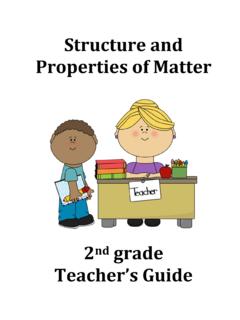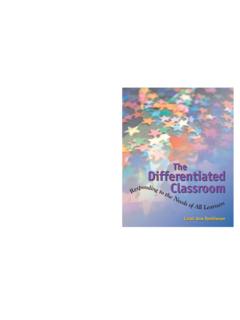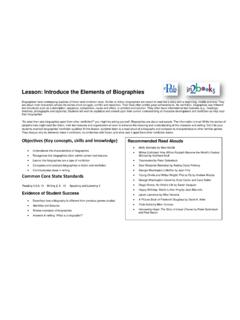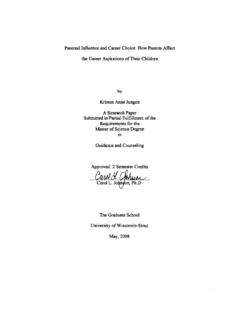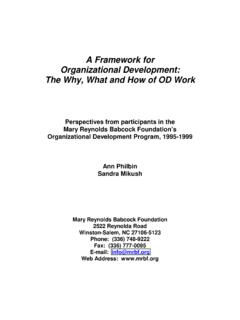Transcription of Carol Ann Tomlinson Differentiated Classroom
1 Carol Ann TomlinsonCarol Ann TomlinsonRespondingtotheNeedsofAllLearne rsDifferentiatedClassroomTheDifferentiat edClassroomTheRespondingtotheNeedsofAllL earnersDifferentiatedClassroomTheDiffere ntiatedClassroomTheEducation$ for Supervision and Curriculum Development Alexandria, Virginia USAVISIT US ON THE WORLD WIDE WEB: s an age-old challenge: How can teachers divide their time,resources, and efforts to effectively instruct so many students of diversebackgrounds, readiness and skill levels, and interests? The DifferentiatedClassroom: Responding to the Needs of All Learners offers a powerful, practi-cal on nearly three decades of experience, author Carol AnnTomlinson describes a way of thinking about teaching and learningthat will change all aspects of how you approach students and yourclassroom. She looks to the latest research on learning, education, andchange for the theoretical basis of Differentiated instruction and whyit s so important to today s children.
2 Yet she offers much more thantheory, filling the pages with real-life examples of teachers and studentsusing and benefiting from Differentiated the core of the book, three chapters describe actual lessons,units, and classrooms with Differentiated instruction in looks at elementary and secondary classrooms in nearly allsubject areas to show how real teachers turn the challenge of differenti-ation into a reality. Her insightful analysis of how, what, and whyteachers differentiate lays the groundwork for you to bring differentia-tion to your own s commonsense, Classroom -tested advice speaks to experi-enced and novice teachers as well as educational leaders who want tofoster differentiation in their schools. Using a think versus sinkapproach, Tomlinson guides all readers through small changes, theneven larger ones, until differentiation becomes a way of life thatenriches both teachers and Ann Tomlinson is Associate Professor of EducationalLeadership, Foundations and Policy at The Curry School of Education,University of Virginia.
3 The Differentiated Classroom :Responding to the Needs of All LearnersTomlinsonTomlinson cover final 12/8/05 9:26 AM Page 1 Association for Supervision and Curriculum DevelopmentAlexandria, VA USAC arol Ann TomlinsonRespondingtotheNeedsofAllLearne rsDifferentiatedClassroomTheDifferentiat edClassroomTheAssociation for Supervision and Curriculum Development1703 N. Beauregard St. Alexandria, VA 22311-1714 USAT elephone: 1-800-933-2723 or 703-578-9600 Fax: 703-575-5400 Web site: E-mail: R. Carter,Executive Director;Michelle Terry,Associate Executive Director, Program Development;Nancy Modrak,Director, Publishing;John O Neil,Director of Acquisitions;Julie Houtz,Managing Editor of Books;Darcie Simpson,AssociateEditor;Ren Bahrenfuss,Copy Editor;Charles D. Halverson,Project Assistant;Gary Bloom,Director, Design and ProductionServices;Karen Monaco,Senior Designer;Judi Connelly,Designer;Tracey A.
4 Smith,Production Manager;Dina Murray,Production Coordinator;John Franklin,Production Coordinator;Valerie Sprague,Desktop Publisher1999 2000 ASCD Executive Council: Joanna Choi Kalbus (President), LeRoy E. Hay (President-Elect), Thomas J. Budnik(Immediate Past President), Bettye Bobroff, Martha Bruckner, John W. Cooper, Michael Dzwiniel, Sharon A. Lease, LeonLevesque, Francine Mayfield, Andrew Tolbert, Robert L. Watson, Sandra K. Wegner, Peyton William Jr., Donald B. YoungCopyright 1999 by the Association for Supervision and Curriculum Development. All rights reserved. No part of thispublication may be reproduced or transmitted in any form or by any means, electronic or mechanical, including photo-copy, recording, or any information storage and retrieval system, without permission from ASCD. Readers who wish toduplicate material copyrighted by ASCD may do so for a small fee by contacting the Copyright Clearance Center, 222 Rosewood Dr.
5 , Danvers, MA 01923, USA (telephone: 978-750-8044; fax: 978-750-4470). ASCD has authorized the CCCto collect such fees on its behalf. Requests to reprint rather than photocopy should be directed to ASCD s permissionsoffice at publications present a variety of viewpoints. The views expressed or implied in this book should not be interpretedas official positions of the in the United States of 1999 member book (pcr). ASCD Premium, Comprehensive, and Regular members periodically receive ASCD booksas part of their membership benefits. No. FY Stock No. 199040 Also available as an e-book through ebrary, netLibrary, and many online booksellers (see Books in Print for the ISBNs). Library of Congress Cataloging-in-Publication DataTomlinson, Carol Differentiated Classroom : responding to the needs of alllearners / Carol Ann bibliographical references and 0-87120-342-11. Individualized instruction.
6 2. Cognitive styles in Mixed ability grouping in education. I..T65 4 dc2199-6162 CIP060504030210987 The Differentiated Classroom :Responding to the Needsof All LearnersForewordv1 What Is a Differentiated Classroom ?12 Elements of Differentiation93 Rethinking How We Do School and for Whom174 Learning Environments That Support Differentiated Instruction255 Good Instruction as a Basis for Differentiated Teaching366 Teachers at Work Building Differentiated Classrooms477 Instructional Strategies That Support Differentiation618 More Instructional Strategies to Support Differentiation759 How Do Teachers Make It All Work?9510 When Educational Leaders Seek Differentiated Classrooms108A Final Thought119 Appendix: Two Models to Guide Differentiated Instruction120 Bibliography125 Index128 About the Author132 ForewordShe waited until they were all in their usual places,and then she asked, Did I choose you, or did you chooseme?
7 And the Souls answered, Yes! E. L. KonigsburgThe View from SaturdayIenjoyed writing this book because itreminded me that teaching is, in part, a his-tory. I enjoyed writing this book because itreminded me ofmyhistory as a this book connected me with teachersof another century in one-room schoolhouses onthe Great Plains of the United States. Theseteachers accepted all comers and said by theiractions, I m grateful for every one of you whocame to learn. Different as you are, we can makethis work! This book also transported me back to latenights at the home of my first real teaching partnernearly three decades ago. She and I tried to makesense of multitask classrooms, which seemed theobvious need of our very diverse students. Afterthree decades of a remarkable friendship, DorisStandridge still works with me to make sense ofteaching and of life. In this book, she also cre-ated all the this book led me to recall the namesand faces of students I taught and who unfailinglytaught me.
8 They were high schoolers, preschoolers,and middle schoolers. They were so alike, yet sodifferent. They needed me to be many things tothem, not just one person, and they taught mehow to achieve book reminded me of colleagues in Fau-quier County, Va. They worked hard, took profes-sional risks, thought outside the box, found joyin classrooms, and created joy there, too. It was aclassy school district, and it was a great trainingground for teaching because there was encourage-ment to be an this book helped me retrace my steps onthe journey of my second life at the University ofVirginia and in schools around the country. I nowwork with teachers in all the different kinds ofplaces that make up the United States and with allthe sorts of students who are its future. At theUniversity of Virginia, my colleagues push mythinking and model excellence. My students oftenask, Why? Then generally they follow with, Why not?
9 Students still are my the country, other teachers questionscreate thick, patterned tapestries of understandingand uncertainty, which generally is the more valu-able for growth. It is a risk to name any morenames. People in so many places have contributedto what I know to write here. In a few places, how-ever, I have lingered longer, and in those places,conversations have been especially am grateful to Mindy Passe, Lynn Howard, theProject START teachers, and many others in theCharlotte-Mecklenburg ( ) Schools; to SusanAllan and the Grosse Pointe (Mich.) teachers; toSuette King and her colleagues in the Ann Arbor(Mich.) Schools; to Terry Greenlund, SandraPage, and a large group of thoughtful teachers inthe Chapel Hill-Carboro ( ) Schools; toMarian Gillewicz and the teachers of Yellowknife(NWT, Canada); to Pam Ungar and the principalsand teachers in the Augusta County Schools(Va.)
10 ; to Peg Davis and her study groups in theMadison County Schools (Va.); and to Mary EllenShaw, Mary Peterson, and the primary teachers atMount Daniel Elementary School in Falls Church(Va.). I ve also been enriched by interactions withprincipals and teachers at three research sites ondifferentiated instruction, where my colleaguesand I have worked over the past three years:Sudbrook Middle School in the Baltimore County(Md.) Schools, Madison Middle School in theRoanoke City (Va.) Schools, and McLean MiddleSchool in the Fort Worth (Tex.) Schools. Ideasfrom many folks in all these places greatly shapethe pages that have directly borrowed (I hope they don tthink stolen!) lesson plans and instructionalapproaches from Nikki Kenney (San Antonio,Tex.); Judy Larrick (Albemarle County, Va.);Taren Basenight, Annie Joines, Jean Parrish,Nancy Brickman, and Holly Speight (Chapel Hill, ); Caroline Cunningham (Peabody School,Charlottesville, Va.)
